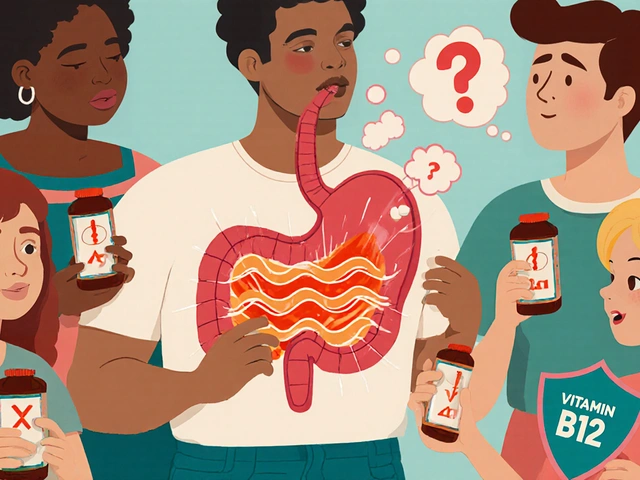If you’re worried about a promethazine overdose, you need plain answers fast. Promethazine can make you sleepy at normal doses and dangerously slow your breathing when too much is taken-especially with alcohol, opioids, or sleep meds. Here’s the practical version: the key signs, what to do right now, what happens in the ER, and how to keep this from happening again. I’ll keep it clear and grounded in current guidance (FDA labeling updated through 2025; American Association of Poison Control Centers 2023 report; ACMT and AAP recommendations) so you can act with confidence.
TL;DR - Key takeaways
- Red flags: extreme drowsiness or unresponsiveness, slow or shallow breathing, bluish lips/skin, seizures, very high body temp, fast or irregular heartbeat. Call emergency services.
- Don’t wait for symptoms if a large amount was taken or if promethazine was mixed with alcohol, opioids, benzodiazepines, or sleep meds. Seek urgent care and contact Poison Control.
- At home: keep the person awake if possible, place on their side if they’re out of it, don’t make them vomit, don’t give food, drinks, or more meds. If you have naloxone and suspect any opioid use, give it.
- In the ER: airway support and oxygen, heart monitoring, IV fluids, charcoal (in select cases), benzodiazepines for seizures or severe agitation, careful blood pressure support. Epinephrine is avoided.
- Prevention: never use in kids under 2; avoid with sedatives and alcohol; lock meds; watch for duplicate antihistamines; follow dose instructions; ask a clinician before combining with other drugs.
Symptoms and red flags: what an overdose looks like
Promethazine is a prescription antihistamine (a phenothiazine) used for nausea, allergies, and motion sickness. It also has anticholinergic and sedative effects. Those properties drive overdose symptoms. Timing varies by dose and route (oral, rectal, IM/IV), but most symptoms show within 1-2 hours of swallowing tablets or syrup and can last 12-24 hours, sometimes longer with big ingestions or mixed drugs (FDA prescribing information; Goldfrank’s Toxicologic Emergencies).
How it shows up, in plain language:
- Central nervous system: heavy drowsiness, confusion, slurred speech, delirium (odd behavior, hallucinations), agitation, tremor, seizures, coma.
- Breathing: slow or shallow breaths; pauses in breathing; snoring respirations that don’t wake them up when you shake them; cyanosis (bluish lips/skin). Risk is much higher if alcohol, opioids (like oxycodone, heroin, fentanyl), benzodiazepines (like alprazolam), or sleep meds are also on board.
- Heart and blood pressure: fast heart rate, low blood pressure (lightheaded, fainting), possible rhythm problems. Severe cases can show wide QRS or prolonged QT on an ECG.
- Anticholinergic signs: hot, flushed skin; dry mouth; big pupils and blurry vision; trouble peeing; constipation; fever. A simple memory trick providers use: “hot as a hare, dry as a bone, red as a beet, blind as a bat, mad as a hatter.”
- Movement: stiff neck, jaw clenching, oculogyric crisis (eyes forced upward), or odd postures. These are dystonic reactions and can be painful but treatable.
- Temperature and muscles: high fever, muscle rigidity, and confusion can signal a rare but serious reaction like neuroleptic malignant syndrome (NMS) because promethazine is phenothiazine-related.
Who’s at higher risk for bad outcomes?
- Children: never give to kids under 2 years-this is a boxed warning due to fatal breathing problems. Older children are still more sensitive to sedation and agitation.
- Older adults: higher risk for confusion, falls, urinary retention, and delirium (Beers Criteria 2023 lists promethazine as potentially inappropriate).
- People mixing meds: alcohol, opioids, benzodiazepines, sleep aids, other sedating antihistamines (diphenhydramine, doxylamine) stack the sedation and breathing risk.
- People with heart disease: risk of low blood pressure and rhythm issues is higher.
- People with urinary retention, glaucoma, or severe liver disease: anticholinergic and metabolic effects can hit harder.

What to do right now-and how the ER treats it
This is the part where minutes matter. Don’t try to be a hero with home remedies. Do the simple, lifesaving things and get help.
Immediate steps at home
- Check responsiveness and breathing. If they’re not waking up or breathing is slow/shallow, call emergency services. Stay on speaker so your hands are free.
- Position. If they’re very drowsy or out, roll them onto their side (recovery position) to keep the airway clear and reduce aspiration risk.
- Don’t make them vomit. Skip food, drinks, coffee, and “sobering up” tricks. No activated charcoal at home.
- Naloxone if any opioid might be involved. Promethazine itself won’t respond to naloxone, but if there’s an opioid on board, naloxone can reverse the deadly part (breathing suppression). When in doubt and you have it, use it and repeat as directed.
- Keep them cool. If they feel hot, use a fan or cool compresses on the neck and armpits-but don’t pack with ice.
- Collect info. Gather the bottle or blister pack, exact product name and strength (12.5/25/50 mg tabs or syrup/rectal), time taken, estimated amount, and any alcohol or other drugs used.
- Call Poison Control for real-time guidance while you wait for help. They know this medication well and will tailor advice to the situation.
What not to do: Don’t leave them alone. Don’t force them to walk. Don’t give stimulants or more meds “to counter it.” Don’t drive them if they’re unstable-risk of sudden vomiting or airway issues is real.
What happens in the ER (based on standard toxicology care; FDA label; ACMT guidance; UpToDate 2024):
- Airway, breathing, circulation first. Oxygen and assisted ventilation if needed. Continuous pulse oximetry and heart monitoring.
- IV access, labs, and ECG. Clinicians look for low oxygen, acidosis, kidney/muscle injury if agitated, and rhythm changes.
- Activated charcoal may be given within about 1 hour of a large oral ingestion if the person is awake and can protect their airway-or via a protected airway in select cases. No ipecac or forced vomiting.
- Benzodiazepines for agitation or seizures. These calm the brain safely without worsening anticholinergic toxicity.
- Fluids and vasopressors for low blood pressure. If pressors are needed, agents like norepinephrine are preferred; epinephrine is avoided with phenothiazines due to potential paradoxical effects.
- Physostigmine may be considered for severe anticholinergic delirium (restlessness, hallucinations) under expert supervision with cardiac monitoring. It’s not used casually, but when used correctly, it can rapidly clear delirium (ACMT/AACT statements).
- Dystonia (painful muscle spasms) can be treated with diphenhydramine or benztropine. Clinicians balance this with the overall anticholinergic picture.
- Arrhythmias/QRS widening: sodium bicarbonate may be used if there’s evidence of sodium channel blockade; magnesium for torsades if QT is prolonged.
- Hyperthermia: active cooling, benzodiazepines for agitation; aggressive care if NMS is suspected (cooling, fluids, sometimes dantrolene or bromocriptine).
- Observation. Many cases are watched for 6-12 hours; longer if symptoms persist, the dose was big, or there were co-ingestants. Children are admitted more often for monitoring.
Good-to-know: There’s no antidote that “reverses promethazine.” Treatment is supportive and targeted to the specific problems that show up. This is normal in toxicology and works well when started early.
Prevention and safer use: simple rules that save headaches
Most overdoses happen because of double-dosing, mixing with sedatives, or using someone else’s prescription. A few quick rules cut risk dramatically.
Never for kids under 2. This is a black box warning for respiratory depression-even at therapeutic doses. In older kids, only use promethazine with clear instructions from a pediatric clinician.
Watch the sedative stack. Don’t combine with alcohol, opioids, benzodiazepines (Xanax, clonazepam), sleep drugs (zolpidem), gabapentinoids, or other sedating antihistamines (diphenhydramine, doxylamine). These mixtures are a big driver of severe outcomes in poison center data (AAPCC 2023).
Mind the dose and strength. Promethazine comes in 12.5 mg, 25 mg, and 50 mg tablets, syrups, and rectal suppositories. If your prescriber changes the dose or form, double-check the strength before taking it. When in doubt, confirm with a pharmacist.
One promethazine at a time. Avoid taking multiple products with promethazine (for example, a tablet plus a combination syrup). Read the active ingredients list; the name might be buried under a brand or combo product.
Respect drowsiness labels. Even “normal” doses can impair driving and machinery use. If you’re new to promethazine or bumped your dose, don’t drive until you know how it hits you-sedation can linger into the next day.
Lock it up. Store in a locked box if there are kids, teens, or visitors in your home. Keep track of pill counts if anyone else has access.
Older adults: ask about alternatives. Because of delirium and fall risk, many clinicians at least try non-sedating options first (e.g., ondansetron for nausea, non-sedating allergy meds). If promethazine is necessary, use the lowest effective dose and avoid other sedatives.
Pregnancy and breastfeeding. Promethazine is sometimes used in pregnancy under medical supervision, but the sedation and anticholinergic effects still matter. Always coordinate with your obstetric provider and avoid mixing with sedatives.
Opioid cough syrups. Some cough syrups combine promethazine with codeine. Because codeine suppresses breathing, mixing these with alcohol or benzodiazepines is especially risky. Many guidelines now discourage codeine-containing cough syrups in kids and teens (FDA, AAP).
Disposal. If you’re done with it, use a medication take-back program or follow FDA flush/disposal guidance for your region. Keeping extra sedating meds around increases the odds of mix-ups.

Mini‑FAQ and quick checklists
FAQ
- How much is “too much”? There isn’t a safe “overdose threshold.” Sensitivity varies by person and by what else is on board. Kids, older adults, and people on sedatives can get into trouble at lower doses.
- Can you just sleep it off? No. People with dangerous sedation can stop breathing in their sleep, especially with alcohol or opioids involved. Get checked.
- How long do symptoms last? Often 12-24 hours for a big oral dose, longer if sustained‑release products, liver disease, or co-ingestants are involved.
- Does charcoal at home help? No. It’s only used in medical settings when benefits outweigh risks.
- Is naloxone useful? It can’t reverse promethazine, but it can save a life if opioids are part of the mix. If you suspect any opioid use, give naloxone.
- What about kids? Under 2: never use. For older kids, dosing should be clinician-directed and carefully measured. If a child took an unknown amount, treat it as an emergency.
- Could this cause a stroke or heart attack? Overdose can lead to low blood pressure and rhythm problems. Shortness of breath, chest pain, or fainting are all reasons to seek urgent care.
- What if it was injected or given IV? The systemic risks are similar or faster-onset; IV promethazine also carries a risk of severe tissue injury if it leaks outside the vein. Any suspected overdose by injection needs immediate medical care.
“Do I need emergency care?” quick guide
If any of these are true, don’t wait-seek emergency care and contact Poison Control:
- They’re very hard to wake, confused, or acting wildly.
- Breathing is slow/shallow, lips look bluish, or snoring is deep and abnormal.
- They mixed promethazine with alcohol, opioids, benzos, or sleep pills.
- There are seizures, a very fast or irregular heartbeat, very hot skin, or profuse sweating.
- Any child took more than prescribed, or amount is unknown.
One-minute home safety checklist
- Check labels: is promethazine hiding in more than one product you use?
- List your sedating meds and supplements (alcohol counts). Any overlaps?
- Set reminders or use a pill organizer to avoid double-dosing.
- Store in a locked place; don’t keep “just in case” extras within reach.
- Ask your pharmacist: any interactions with your current meds?
What to tell the ER or Poison Control
- Exact product and strength (tab/syrup/suppository; 12.5, 25, or 50 mg).
- How much was taken, when, and by which route.
- Age, weight, conditions (heart disease, glaucoma, urinary retention), and all other meds or substances (alcohol, opioids, benzos, sleep aids, antihistamines).
- Symptoms you’ve seen and when they started.
Next steps and troubleshooting
- If symptoms are mild and Poison Control advises home observation, stick to their plan: no driving, no alcohol, no other sedatives, stay hydrated, and have someone awake with the person for at least 12 hours.
- If nausea/vomiting hits, avoid dehydration; small sips of clear fluids as allowed by Poison Control or your clinician. If vomiting persists, seek care.
- If agitation or confusion worsen, or new symptoms appear (chest pain, shortness of breath, fainting, seizures), switch to emergency care.
- After recovery, book a medication review. Ask about safer alternatives for your use case (for nausea, motion sickness, or allergies) and interaction checks with your current meds.
Why trust this? The safety points here match FDA-prescribing guidance through 2025, the AAP stance on pediatric use, the Beers Criteria for older adults, and toxicology practices summarized by ACMT/AACT and current emergency medicine references. The AAPCC’s 2023 report continues to flag sedating antihistamines as a common overdose exposure, often with co-ingestants. Promethazine’s risks are well-known and preventable with simple steps.
Bottom line: Act fast on red flags, don’t try risky fixes at home, and build a simple prevention routine-no mixing with depressants, careful dosing, and locked storage. That’s how you keep a rough night from turning into something far worse.





One comment
If you’re navigating a promethazine overdose scenario, the first priority is airway, breathing, and circulation stabilization. Rapid assessment of respiratory rate, oxygen saturation, and mental status guides the urgency of emergency services activation. Concurrently, positioning the patient in the recovery lateral decubitus mitigates aspiration risk while preserving a patent airway. It’s critical to avoid induction of emesis, as this can exacerbate pulmonary injury and compromise the gag reflex. Documenting the exact formulation, dosage, and temporal window of ingestion streamlines toxicology consultation and antidotal considerations. While naloxone does not antagonize antihistamine toxicity, it remains indispensable when opioid co-ingestion is suspected, as it can reverse respiratory depression. Activated charcoal may be appropriate within the first hour if the patient is alert and airway-protected, though recent guidelines caution against routine use without clear indication. Monitoring for anticholinergic toxicity signs-hyperthermia, mydriasis, dry mucous membranes-should prompt consideration of physostigmine under cardiac telemetry. Dystonic reactions, though less common, can be swiftly managed with diphenhydramine or benztropine to alleviate severe muscular spasms. Continuous ECG observation is advisable to detect QRS widening or QT prolongation, which may necessitate sodium bicarbonate or magnesium therapy. Fluid resuscitation and vasopressor support are tailored to hemodynamic status, favoring norepinephrine over epinephrine due to phenothiazine interactions. Finally, post-recovery counseling on medication storage, dosing accuracy, and avoidance of polypharmacy is essential to prevent recurrence.
Think of the overdose as a cascade of physiological events, each one feeding into the next. By interrupting that cascade early-securing the airway and calling help-you change the trajectory. It also helps to keep a calm demeanor; the patient picks up on that energy. Sharing the exact medication details with clinicians empowers them to tailor the interventions. Remember, prevention is just as important as the acute response.
Don’t wait-call 911 now.
The toxic profile of promethazine is a perfect storm when mixed with depressants. You’ll see anticholinergic signs like a flushed, dry skin, and that “hot as a hare” meme becomes a real concern. If a patient is showing seizures, it’s not just the drug‑induced hyperexcitability; it’s also the hypoxia compounding the issue. Rapid cardiac monitoring is non‑negotiable; QT prolongation can sneak up on you. And, oh‑my‑god, never, ever induce vomiting-it’s a recipe for aspiration. Side note: I accidentally typed “dop” instead of “top” in my note-sorry for the typo, but the advice stands.
Hey folks, just a quick reminder to lock up your meds and use a pill organizer. Double‑checking the label can prevent accidental double‑dosing, especially when you have multiple antihistamines at home. If you ever notice someone looking unusually drowsy after taking promethazine, treat it as an emergency and get help right away. It’s better to be safe than sorry, and your loved ones will thank you for the extra vigilance.
Just keep an eye on breathing and make sure they stay awake if they can you dont want them to pass out if they look weird call 911 pronto
When dealing with a potential overdose, it’s vital, to, be, thorough, in, documenting, the, dosage, and, timing, of, the, medication, because, this, information, guides, the, emergency, team, and, ensures, appropriate, interventions, are, applied, promptly.
I think it’s good to remind people that you should never let a child near these pills. Even a tiny amount can be dangerous. If you’re unsure about any symptoms, call poison control for guidance. Stay safe and keep your meds organized.
Bro, keep the meds locked away and don’t mix them with alcohol. If anything feels off, get help fast. Simple steps can save lives.